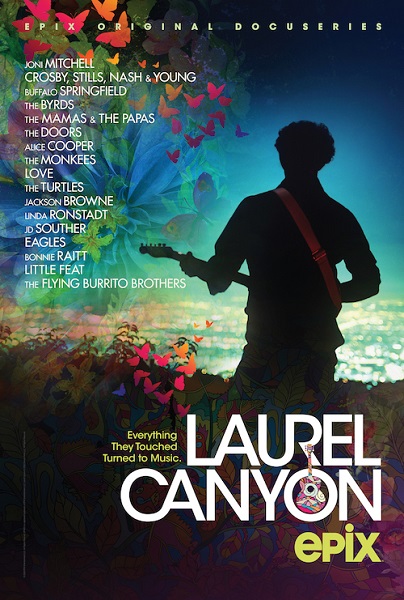Expounding on the concept of a ‘place and a time’ setting the wheels of culture in motion, Laurel Canyon, a two-part docuseries from the EPIX premium television network, reveals the time and extraordinary place of LA’s rock music makers and shakers who created an iconic music scene in the mid 60s and early 70s.
Directed by Alison Ellwood, who directed the expansive and enlightening History of the Eagles, this series offers voice-over as well as on-screen interviews with notables like Jackson Browne, Don Henley, Michelle Phillips, Graham Nash, Linda Ronstadt, and Roger McGuinn, plus oh-so-rare and lots of newly unearthed footage and audio recordings.
Part one focuses on the Byrds, the early folk scene, and the burgeoning community that was growing in the canyon roads high in the Hollywood Hills. Opening with an on-camera interview with photographer Henry Diltz, we get into the history of the place (Diltz played in folk bands in the LA area before taking up photography), looking at iconic photos of rock luminaries of the time, whom he photographed as well as befriended.
In addition to the Byrds, Buffalo Springfield, the Mamas & The Papas, Love, Joni Mitchell, Alice Cooper, and of course Crosby, Stills, Nash, and Young fed this growing artistic community. The first half of the series ends with Woodstock; the second half focuses on the aftermath — Vietnam, Nixon, assassinations, the Manson killings (which David Crosby points out happened too close to his house in Laurel Canyon) and the tragedy of the Altamont concert starring the Rolling Stones.
While CSNY were imploding, managers Elliot Roberts and David Geffen established Asylum Records to give Jackson Browne a home and what is called the ‘second wave’ of singer-songwriters who made the canyon home. Suddenly Linda Ronstadt, Bonnie Raitt, Little Feat, and the Eagles, with their unmatched success, took the music to new heights.
Popular LA disc jockey Jim Ladd weighs in, as does Henry Ditz again. We see the scene splintering, with bands taking to stadiums instead of clubs like the Troubadour (which could no longer hold their legions of fans) and then the final nail in the coffin — the death of “Mama” Cass Elliot.
David Crosby compares the artistic community that arose in Laurel Canyon at his time to Italy during the Renaissance. Arguably a case could be made pro or con for that observation. Still, there is no denying that Laurel Canyon was a special place to a number of artists who made a real difference in modern culture during such a brief amount of time.
Laurel Canyon premieres May 31st at 9 PM ET/PT and concluding the following Sunday, June 7th at 9 PM ET/PT. For more information about EPIX, go to www.EPIX.com.
~ Ralph Greco, Jr.




















